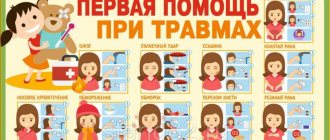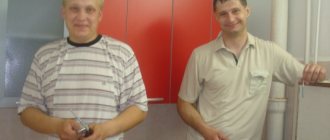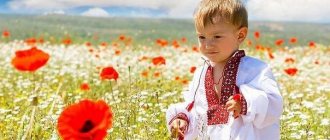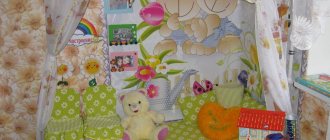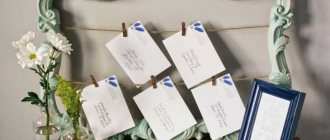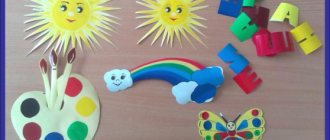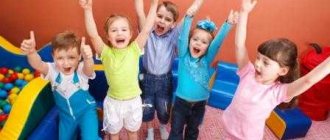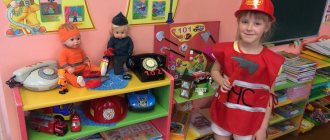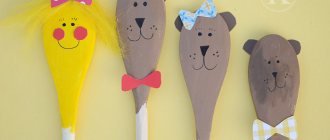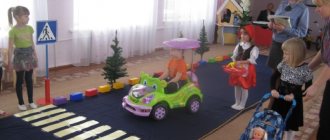What is it for?
Raising a patriot cannot be successful without referring to the culture and history of one’s region. Today, much of the life of our ancestors has been lost and forgotten, the way of life of the people has changed greatly, and we turn so little to our roots, but the unique culture of the Russian people has been formed over centuries and is full of various customs, traditions and rituals.
Knowledge and understanding of folk culture, the desire to join its further development in the future will become motives for active creative activity of a person if patriotic education begins from early childhood.
Decorating a patriotic corner in a kindergarten with your own hands will help teachers and parents organically introduce the child to the world around him, introduce him to his native culture, the eternal and the beautiful.
Where to start?
It is still difficult for kids who have just arrived in kindergarten to think in terms of a city, country, or culture. For them, the homeland is their immediate environment, so information about home and family that is accessible to children of this age should be contained in a patriotic corner in the kindergarten. The design of the 1st junior group requires a simple but bright design. It is important to attract children's attention and arouse their interest. At this age, speech is actively being formed, so everything should contribute to development, encourage the baby to recognize and name. Children can first simply observe the activities of adults who look at albums, naming all family members in the photos. Gradually, imitating adults, they themselves will begin to do this.
Speech development corner in kindergarten - design according to the Federal State Educational Standard, examples
Mastering oral speech is an important process in the development of a child’s personal qualities. The preschooler’s active vocabulary is replenished, the ability to ask questions, formulate thoughts and draw conclusions develops. The formation and improvement of speech skills is carried out simultaneously with the development of mental and psycho-emotional abilities. Speech is a tool in research and creative activity, an opportunity to communicate with peers and adults.
Creation and work of a speech development corner in kindergarten: role, significance, goals and objectives
The child’s speech develops gradually. By the age of 1.5 years, the first simple sentences appear: “Give me a drink,” “Give me,” etc. By the age of three, the vocabulary is approximately 1,500 words, the child composes complex sentences, uses conjunctions, and comes up with new words. Thus, already in the younger groups of kindergarten, increased attention is paid to speech classes with children.
It is necessary to pay attention to speech development from an early age of the child.
The process of speech acquisition is a complex process that occurs in all types of children's activities. The Federal State Educational Standard (FSES) identifies a separate area - “Speech development” - and puts forward requirements for the work of a teacher in this area. In addition to developing and conducting standard and integrated speech classes, the teacher of a preschool educational institution is tasked with organizing the subject-spatial environment in the group. In order to develop and, if necessary, correct the speech skills of pupils of all ages, several corners are set up - book, speech therapy, theatrical and speech.
Speech development of pupils is carried out in standard classes
The speech corner involves conducting classes individually and in subgroups of 2-3 students. It also becomes one of the centers of children’s independent activity; they are pleased and interested in studying visual materials and playing here. The purpose of creating a corner for speech development is the optimal organization of a developmental environment for improving the speech abilities of pupils.
The materials and design of the speech corner are attractive to children and arouse interest.
The tasks of the speech corner directly depend on the age and individual characteristics of the children.
Table: tasks of the speech corner
The purpose of speech exercises is to develop facial and articulatory skills
Making a speech corner with your own hands
The speech development center is equipped and staffed in accordance with the age of the pupils. Thus, every year it is transformed and enriched to make it interesting and productive for children to study here.
For younger preschoolers, the speech development corner may include a sensory area - a place for the development of fine motor skills. As an option, this is a table with educational games: pyramids, a sorter, books and toys with buttons, bags for seeds and pebbles.
In the speech corner of the younger group, you can arrange a table with games for the development of sensory perception
Or it’s a rug on the wall with beepers, rubber bands, a plastic mirror, buttons, felt pictures, ribbons, and Velcro. The sensory mat usually depicts the plot of a fairy tale familiar to children (“Turnip”, “Teremok”, “The Three Little Pigs”) or images of natural objects, animals: flowers, trees, butterflies, birds, bunnies, etc. Everyone knows that a child’s first he actually wants to touch the object that interests him, so a developmental rug is made from pieces of bright fabric, scraps of velvet, printed ribbon, and colorful braid.
Fun images on the rug attract children and encourage active sensory perception of textile images
In recent years, busy boards have become popular as equipment for sensory development - boards or stands with objects attached to them, which small children are usually forbidden to touch. It is easy to make a business board with your own hands: various locks (latch, door hook, latch), bicycle and door bells, buttons and switches are glued or screwed onto a plywood sheet.
The development of sensory perception and fine motor skills is facilitated by the study of the so-called. "busy boards"
For all age groups of preschoolers, objects and play sets for the development of speech breathing should be presented in the corner. For these purposes, waste material and simple toys are used: plastic tubes and cups, ping-pong balls, cotton balls, plumes and pinwheels, flags, balloons. The teacher includes breathing exercises in play activities: “Put the ball into the goal”, “Raise the sails!”, “Shallow, shallow, mill!”.
Simple materials were used to create the game: cardboard, colored paper and cotton balls.
In the speech corner of the senior and preparatory groups, a place is set up for board and printed games. The selection is made up of games with letters and words:
- “Entertaining ABC”: for cards with letters (uppercase and printed), you need to select cards with images of objects for these letters.
- “ABC Lotto”: cards with beeches are filled with chips with animals whose names begin with these letters.
- “Kaleidoscope of Letters”: children learn to recognize the symbolic designations of letters on the playing field.
- “Make a word. Dominoes: cards are used to create an image and its name.
- “Who lives where”: cards with words, animals and their habitats.
Such games teach children to add syllables and words, as well as develop speech abilities in group play.
To stimulate children's verbal creativity and play dramatization games, a small area with a screen, decorations, and dolls is set up in the corner. Unlike the theatrical activity corner, the space for performances in the speech corner is limited. For example, you can cover a cardboard box - it will be a fairy-tale forest for the figurines. Dialogue using hand puppets and bibabo can be acted out from behind a folding paper screen.
Dolls and decorations stimulate children's independent speech creativity
Requirements for the speech development corner according to the Federal State Educational Standard for Preschool Education
- Optimal location: the corner is sufficiently lit, located in a quiet place next to the book, theater and sensory development corners.
- Compliance with the age and individual needs of children.
- The presence of an animated character - a doll or toy. The character who owns the corner encourages children to engage in speech activity: he tells funny stories, invites them to play, and asks questions. With the help of an animated toy, motor exercises and articulatory gymnastics are demonstrated.
- Aesthetics. The corner is designed in the same style as the areas for artistic reading and theatrical activities. The place of study attracts not only with bright colors, but also with interesting objects: reproductions on the wall, figurines on the shelf. Didactic and gaming materials are located in a corner by topic, and students learn to maintain order.
- Safety. Pupils of the first and second junior groups independently practice the development of fine motor skills under the supervision of a teacher (due to the danger of small parts getting into the respiratory tract). It is not recommended to equip the speech corner with hanging shelves or cabinets with glass doors. Electrical appliances and power supplies must be out of the reach of children.
An example of designing a speech corner in the middle group - video
Speech Corner Passport
A kindergarten corner passport is an information document that describes the state of the activity center, equipment and subject content. The passport is drawn up by the teacher and certified by the administration of the preschool educational institution, stored in the teacher’s document folder or in a special cell in the corner. Colleagues, young professionals, and parents of students can get acquainted with information about the contents of the corner. A passport is required to nominate a corner for a competition of pedagogical projects to organize a subject-development environment for children.
Sample speech corner passport template:
- Name of the corner, age group.
- Tasks of the corner (briefly).
- Furniture items, quantity.
- Electrical appliances, if any (audio player, projector).
- List of visual teaching aids (posters, mnemonic tables).
- List of demonstration materials (thematic pictures, cards-schemes).
- Didactic and board games.
- Sets for breathing exercises and dramatization games.
- Card file of speech exercises and games.
Fragment of the passport of the corner for speech development: visual, didactic and demonstration materials - table
How to name the corner of speech development
The name of the developmental activity corner in kindergarten should be short and understandable. Traditionally, the activity center is named after the actual focus of the activity. Since a mandatory attribute of a speech corner is an animated toy, the name of this fantasy character is often used in the name. Unusual and funny names arouse additional interest among students. You can arrange a competition for children and parents to come up with a name.
- Classic names: “Speech Corner”, “Speech Coach”, “Speech Development Corner”, “Learning to Talk”, “Speech Development Lessons”.
The traditional name reflects the direction of development of children's abilities in the corner - Titles with the name of the owner of the corner: “Lessons of Aunt Owl”, “Hello, Dunno!”, “Visiting Luntik”, “Button Invites”, “Talker”, “Mushka the Talker”, “Bunny the Lopotushka”.
The corner is named after an animated character - the hare Govorushi - Funny names: “Let's Talk”, “Gazebo”, “Zvukarik”, “Govoryashka/Govorusha”, “Azbukvarik”, “ABVGDEyka”, “Govorilki”, “Logostrana”, “Let’s Sit and Talk”, “Rechetsvetik”.
Funny names attract children to explore the corner
Speech Corner Design Tools
The corner is organized in the group’s premises with the aim of developing children’s speech abilities and, by its design, encourages pupils to express opinions, joint discussions, and conversations. Both children and their parents are involved in drawing posters, wall newspapers and pictures.
Plates and emblems - photo gallery
Signs for all corners of the group can be made according to a single template. The sign can depict a favorite character to attract the attention of children. The sign is attractive and evokes a positive attitude towards activities in the corner. The sign contains the original name of the corner and an image of its owner.
Signs and emblems with the name of the corner are a mandatory element. design: they indicate the direction of educational activity, contain the name and sometimes an image of a character beloved by children. It would be aesthetically sound to make a plate in the same style for all activity zones in a group, or to maintain uniformity in the logos of speech development centers.
Pictures - photo gallery
Drawings can represent animated characters that give children speech exercises. Images of fairy-tale characters decorate the walls of the corner. Pictures based on children’s favorite fairy tales serve both as decoration for the corner and as materials for constructing a story. Pictures indicate one of the areas of work of the speech corner - familiarization with letters and sounds.
Pictures and drawings decorate the walls and furniture in the group’s premises. To design the speech development corner, images of fairy tale and cartoon characters, animals, and letters are used. At the same time, the pictures in the speech corner are functional; children can be asked a question about them or come up with a task aimed at developing oral speech: “Who is shown in the picture? Describe what he is like,” “Say hello to Dunno. Tell him how your day was,” “Come up with a short story based on this picture,” etc.
Stand - photo gallery
A stand with plastic cells is suitable for displaying information for parents and picture diagrams for children. On the stand, the teacher places didactic
How to fill the patriotic corner in the nursery group?
This can be any material on social and moral development:
- Thematic folders containing illustrations with images of family members demonstrating their relationships, care, and joint affairs.
- Photo album “My Family” with images of pupils in a family environment.
- An album or exhibition “Here we live”, in which you can place photographs, illustrations or models of streets or various architectural buildings (kindergarten, school, houses where children live, other city objects).
- Exhibitions introducing the origins of Russian folk culture, which may contain a variety of antiquities, traditional toys (wooden and rag dolls), amulets, exhibits of decorative and applied art (painted nesting dolls, trays and other utensils with Gorodets, Khokhloma and Gzhel painting, Dymkovo toys , embroidered towels, scarves, knitted napkins, tablecloths and other items).
Fiction, works of folklore - songs, jokes, nursery rhymes and fairy tales - can also be placed in a patriotic corner in a kindergarten. The design of the nursery is meant to be colorful and understandable; it should not contain a lot of text; it is better if it is visual material that attracts the attention of children and their parents. It is important to remember the safety requirements, which are the same for all corners: all materials must be placed so that they cannot fall or injure the child. No sharp corners or edges are allowed.
Local history corner in kindergarten presentation for a local history lesson
Slide 1
Equipping a local history corner in a kindergarten Completed by: Educator Tatyana Vasilievna Voronkova
Slide 2
The purpose of creating local history corners is a comprehensive study of your hometown, the region in which you live.
Slide 3
Objectives: • Teach the child to understand that both people and things have their own history • Awaken in young citizens a feeling of love for their city, respect for its traditions and customs • Form a unity of aesthetic feelings and moral values • Awaken emotional responsiveness in children through introduction to art, music, literature, folk culture
Slide 4
Corners must meet certain requirements: • Good illumination during the day and evening • Expediency of placing exhibits • Accessibility • Aesthetics • Scientific • Reliability of the material presented The material offered to children in the centers must necessarily change depending on the age of the children.
Slide 5
Junior preschool age (3rd-4th year of life) The main goal of patriotic education is familiarization with the immediate environment. Albums: “Our Family”, “City Streets”, “My City”, “Our Kindergarten”, “Holidays at Home and in Kindergarten”, “Know Yourself” Fiction: poems about our hometown, stories and legends of our region, fairy tales, nursery rhymes, tongue twisters. Illustrations: “Nature of our native land”, “Flora and fauna”, “Our city in all seasons”. Pictures - illustrations: “The work of adults”, “Children living in other cities”. Drawings by children and adults about themselves, the city, and the surrounding nature. Collaborative works from waste and natural materials. Samples of decorative and applied arts. Dolls in Russian costumes.
Slide 6
Average age. (5th year of life) Albums listed above + “My Russia” Thematic folders with photographs and illustrations, postcards, albums dedicated to the sights of the city and its famous residents, transport, architecture, professions of residents. Materials about the history of the city can be presented. various layouts (peasant hut, room - upper room, peasant farmstead, etc.); K dolls in Russian costume D educational games; Fiction (fairy tales, songs, proverbs, sayings, poems, riddles of the people, about the city, about Russia.) Elements of state symbols (flag, coat of arms of Russia); Elements of regional symbols (flag and coat of arms of the region, the city in which you live); Material dedicated to the defenders of the Fatherland: thematic folders with illustrations. Mini museum: Elements of clothing, Utensils of the people, Musical folk instruments Audio and video materials about the nature of the native land
Slide 7
Older age (6-7 years of life) Should be located in the work area, very actively used by children of senior preschool age, as a place for individual and subgroup independent games and activities with various types of materials. Working in a corner can replace a traditional activity. Family photo albums, homemade books on the topics “My family’s coat of arms”, “Family tree”; "Kindergarten". Thematic folders with illustrations and photographs: “History of the city”, “City industry”, “Science, education and culture”, “Famous fellow countrymen”, “Folk costume”, “City attractions”, “Architecture”, “Sport”, “ Natural resources”, Mini-museum (“Items of Russian everyday life”; “Past and present”, etc.); A selection of poems about the city. City map. Symbols of the city (flag, coat of arms). Layouts (neighborhood, street, architectural structures); “My Land”: map and symbols of the region; material introducing children to the glorious past of their native land (history of cities and their present; agriculture); Map of the Russian Federation. It is desirable that this map be intended for children and contain the necessary material about the cities of Russia (the capital of the Motherland, the symbols of the cities, the main attractions); about natural areas; about the peoples inhabiting the country; about industry and agriculture. Symbols of Russia (coat of arms, flag, anthem). Portrait of the country's president; Thematic folders with illustrations: “Our Ancestors”, “Heroes of the Russian Land”, “The Great Patriotic War”, “Russian Army”. Photo album “Monuments of military glory”. Fiction. Didactic games on the topic. Models (ancient fortress, military equipment, etc.); Material for introducing children to the origins of Russian folk culture: illustrations and thematic folders “How people lived in Rus'”, “Ancient objects”, “From the history of Russian folk costume”, “Folk holidays”, “Folk calendar”; antiques. Material that gives children an initial idea of Orthodoxy: a selection of illustrations depicting temples, a set of “Russian Icon” postcards, a model of a temple; Globe, world map (for children).
Slide 8
Thank you for your attention!
Older children - tasks are more difficult
More complex concepts become accessible to the understanding of four-year-old children, therefore, complementing and developing the topics covered in younger groups, teachers and parents continue the direction of education we are considering, placing new materials in the patriotic corner in kindergarten. The design should influence the development of the child’s personality. It is important that not only literature, illustrations and teaching materials are used, but also elements of independent and joint activities. Preschoolers can play with friends or with adults, mastering the posted materials and making interactive connections.
The design of a patriotic corner in a kindergarten in the middle group should be beautiful, bright, attractive and interesting for children. There can be nothing damaged, broken or torn here. It’s good if the colors and shades used are correctly combined with each other and are pleasing to the child’s eye. All materials are updated from time to time.
In the middle group, most of the patriotic work takes place in and outside of class. These include purposeful walks along nearby streets and getting to know the administrative buildings located on them (shop, pharmacy, post office, etc.), reading fiction, talking with children about the nature of their hometown. All new information that children receive should be supported by materials in the patriotic corner.
visual aid “A Corner of the Native Land”
| Author: Pomaskina Natalia Alexandrovna, teacher MADOU "Combined kindergarten No. 46" Tobolsk. |
visual aid “Native Corner” (a corner for observing changes in nature)
Brief summary:
Age category: 3-7 years.
Goal : to systematize children’s knowledge about the nature of their native land at different times of the year.
Tasks :
— to form ideas about seasonal changes in nature, about the seasons;
- develop curiosity and observation, the ability to see the beauty and uniqueness of nature at different times of the year;
— consolidate knowledge about trees, birds and animals of their native land;
- expand your vocabulary, develop coherent speech when composing descriptive stories about the weather, the time of year;
- develop visual arts skills, fine motor skills, fantasy and imagination when decorating a corner, making sketches about changes in nature;
- cultivate love for the native land.
Working method:
There are various calendars and albums for sketching daily weather observations. The children and I created a corner of our native nature in the group, where we note various seasonal changes in nature. This form of work develops in children knowledge about the gradual, consistent change of foliage on trees, its rate of fall, the arrival and life of birds in the forest.
For example: in the fall, children found beautiful golden birch branches and placed them in a corner, after a while - a branch of bright variegated rowan, then aspen, bird cherry, oak, and maple appeared. The children admired the corner they had created with their own hands. Notice that the oak remains green. Then, also gradually, the children noted from which tree the leaves began to fall off, and observed leaf fall not only on the street, but also in the corner of the group. The children found out that every tree has seeds. They made puddles out of paper, glued leaves to them with tape, and they got frozen leaves in puddles. Gradually, the children sprinkled the entire corner with snow (cotton wool), and it turned out to be late autumn.
In winter, we made birds (tits, bullfinches) and placed them on a rowan tree (there were no leaves, but the berries remained). In our corner, we noted all the changes that the children talked about (footprints, ski tracks).
Spring came (change of pictures), the snow melted (the cotton wool was removed), the children found and brought a blossoming willow twig to the corner, drew streams, dark paths, cut out puddles, rooks.
With the changes in the nature of our native land in the spring, interesting work continues in our corner. Spring dragged on this year, snow fell again and it also appeared in our corner. What will our calendar look like in the summer? Children will decide this based on their observations about the weather.
Daily work with this visual aid develops in children an interest in nature, a desire to notice something unusual in nature and tell friends in the group about it, and make changes to our calendar themselves. In addition, this manual can be used to form mathematical concepts, to develop coherent speech, to develop artistic creativity skills, because everyone wants to create their own small album of observations of the nature of their native land.
1 vote was given for this work.
Voting ended on April 13, 2014 at 11:00 p.m. Thanks everyone for participating!
Share
Contents for the middle group
Children of this age will find the following materials interesting and useful for their development:
- illustrations of family holidays and traditions, fiction on moral themes;
- photographic materials, illustrations, albums, postcards, thematic folders introducing the history of the native city, its famous residents, and attractions;
- exhibits that introduce preschoolers to traditional culture: antique objects, folk toys, examples of decorative and applied arts, themed didactic games;
- works of folk art - from songs to fairy tales;
- symbols of the state, region and city.
Design of a national corner in the middle group
Irina MALINOVSKAYA
Design of a national corner in the middle group
An important component of the educational environment in the group is the national corner . It has the function of instilling in children patriotic feelings, love for their native land and pride in it. Its content will make it possible to organize the educational process in a group a way as to form in a simple and relaxed form in children involvement in the modern events of their native country, initial ideas about national cultural traditions, about their small Motherland, national and state holidays. The national corner contributes to the formation of ideas about how people live in the republic, its geographical location, symbols of the state, attractions of their hometown, capital, traditional crafts, arts and crafts, and leading industrial enterprises. Creating an emphasis on the cultural features of the native land is the main thing in organizing a national corner . The nuances of its design depend on the age of the children and the creative approach of the teacher.
We live in the capital of the Republic of Belarus, the hero city of Minsk, so the main place in the national corner of our group is occupied by the symbols of Belarus and its capital: the flag, the coat of arms.
To develop knowledge about the geography of the native country, in the corner there is a geographical map of Belarus, a panel “Relief map of the Republic of Belarus”
.
We placed dolls in national Belarusian costumes in the corner
With the help of the pupils' parents, they collected a small collection of Belarusian arts and crafts: Belarusian toys (clay, wood, straw, woven and embroidered products, ceramics, products made from straw, flax, wicker, wood.
The central place in our collection is occupied by the straw “spider”
, donated by a folk artist.
Straw "spider"
- This is one of the most ancient creations made from straw.
Since ancient times, the Belarusian people believed in the miraculous power of the “spider”
.
A straw “spider”
suspended from the ceiling is not only a product of a folk craftsman, a decoration for our
group , but also a talisman.
For independent activities of children, albums on various topics are decorated in the corner In the album “Our Minsk”
collected colorful photographs of our beloved city - the capital of our country.
To the album “We are factory workers”
included illustrations about the industrial enterprises of the Zavodsky district in which we live.
Album “Belarusian patterns”
introduces pupils to the peculiarities
of national embroidery and weaving.
Album “Memorable places of Minsk”
tells the children about the most dear places for Minsk residents in the capital of our Motherland.
To the album “Symbols of our Radzima”
images of the coats of arms of the most ancient cities of our republic are included.
To introduce children to folk musical instruments, we have designed the album “Arkestar of Belarusian Folk Instruments”
.
Album “May Radzima – Belarus”
tells preschoolers about the territorial division of the republic, about its regional centers.
In the album “Our Museum”
collected interesting historical information about household items and clothing of the Belarusian people.
The corner contains educational and encyclopedic literature for viewing,
There are portraits of Belarusian artists, composers, writers.
To consolidate children’s knowledge and ideas about their native country, we collected a card index of didactic games to familiarize themselves with the decorative and applied arts of Belarus, and produced didactic games “Travel to Minsk”
(in Belarusian language
“Padarozhzha na Minsku”
,
“Traveling around Belarus”
(in Belarusian language
“Vandruem na Belarus”
,
“What is it made of?”)
.
The national corner of the group is our pride!
What do we call home?
In older preschool age, the tasks of patriotic education become more complicated, children continue to get acquainted with their native land, study not only their city, but also the region and the country, receive information about state symbols, the historical past of Russia, and the national calendar.
The material placed in the patriotic corner in kindergarten also becomes more complex. The decoration is complemented by children's and family creative works. For example, while continuing to study the topic “My Family,” children and their parents create a family coat of arms or family tree. Family albums placed in the corner, which children love to look at and show to each other, will also be interesting.
From hometown to country
Various materials on the following topics will help you continue your acquaintance with your hometown: “How did the city arise?”, “What is produced in our city?”, “The culture of my city,” “Famous fellow countrymen,” “During the Great Patriotic War,” “Sights” , "Architecture". Parents and educators can jointly create a selection of poems about the city.
The map of the locality and its symbols should also replenish the patriotic corner in the kindergarten. The design of an exhibition about the native land may contain symbols and a map of the region, information about its cities and famous places, and when children perceive this information, they will be ready to get to know their native country. Here you can’t do without a map of Russia. Modern printing produces special children's cards containing material accessible to children's understanding. And, of course, Russian symbols should appear in a prominent place - the coat of arms, flag, anthem and portrait of the president.
About culture, defenders of the Fatherland and planet Earth
In addition to local history information, other topics and areas contribute to patriotic education.
If the necessary material is available, information about how the culture of our people was born is posted in the patriotic corner. These could be thematic exhibitions “How did people live in Rus'?”, “What do ancient things tell about?”, “From the history of Russian folk costume”, “How did people walk and have fun?”, “Folk calendar” and others.
Information about the defenders of the Fatherland can also replenish the patriotic corner in kindergarten. The design (photo below) of exhibitions about the heroes of the Russian land, the Great Patriotic War and the Russian Army can arouse the interest of boys and instill in them a desire to become a defender of their homeland.
The global task of patriotic education is to form in children the concept that planet Earth is our common home, and everyone who lives on it should live in peace. Children need to be introduced to the living conditions of people in other parts of the planet, their customs and traditions.
If teachers and parents are interested in educating a young citizen, then the result will not be long in coming, and the corner of patriotic education will help in this.
Local history corner in the developing subject-spatial environment of the group
Modern teachers believe that the basic stage of developing love for the Motherland in children should be considered their accumulation of social experience of life in their village, assimilation of the norms of behavior and relationships accepted in it, and introduction to the world of its culture. Love for the Fatherland begins with love for one’s small Motherland - the place where a person was born.
Psychological and pedagogical research has shown that local history classes are available to preschool children.
What is local history? Local history is the study of a certain part of the country, city, village or other settlements by the local population, for whom this territory is considered their native land. “Edge” is a conditional concept and depends on who is studying it and for what purpose. This could be a city, a district, or a street, that is, what surrounds us.
One of the important conditions in the work on local history is the creation of a developing subject-spatial environment in the group.
When designing and selecting materials to create a local history corner in our group, we adhered to the following rules:
— the material must be understandable and accessible to the age of children;
— the materials must be sufficiently bright and saturated;
- provide children with the opportunity to participate in creating a corner.
The corner is located in an accessible and safe place. Children can take materials, games, and objects from the man-made world. Also, the corner can be transformed into a mini-museum, workshop, or exhibition of children's creativity. The presence of multifunctional objects, including natural materials, for use in various types of children's activities, including as substitute objects.
An important condition for success in this work is close communication with parents (legal representatives). We took part in collecting local history and educational material to replenish the local history corner: family photos, a laptop, information about Irgiz, the village, the “Love and Know Your Land” stand, design of the exhibition “Unofficial Symbols of Russia.
The information in the corner is presented in sections:
- “My family”: family photos, family tree, lapbook, children’s drawings, poems, statements about family, educational games.
- “Kindergarten”: group plan, photos of kindergarten staff, poems, we are working on creating an album “Our everyday life and holidays.”
- “Native Village”: album “Our Land”, photos of attractions, photos of famous people of the village, magazines, coat of arms of the village, information about the Irgiz River, about the village, visual illustrated and reference material “Animals and Plants of the Native Land”, game “Fifth Odd” , children's drawings.
- “The City of Samara”: map, symbols, photos of attractions, a set of postcards.
- “Country Russia”: map, symbols of the country, photo of the president, didactic game “My Russia”, illustrated and reference material.
- “Our Army”: didactic material, albums for viewing, awards of the Great Patriotic War, folder “May 9”.
- “Russian National Culture”: mini-museum of applied art - products of folk craftsmen: matryoshka, whistles, Kargopol, Fillimonov, Dymkovo toys, Zhostovo tray, Vologda lace, birch bark products, Khokhloma spoons, model “Russian hut” rag dolls, visually illustrated material: “Folk traditions and holidays”, “Russian costume”, “Folk paintings”.
The tasks of moral and patriotic education are implemented not only through the content of the local history corner , but also through the content of other areas of independent children's activity:
— samples of decorative and applied arts are presented in the children's creativity center;
— in the center of the game there are thematic sets for role-playing games: “Barbershop”, “Hospital”, “Shop”, “Farm”. These games help enrich children's ideas about professions.
— in the corner of cognitive development there are games, lotto “Professions”, a floor folder, poems;
— Russian folk tales, epics, and small folklore forms (rhymes, riddles, poems) are placed in the literary center.
Thus, not only the local history corner, but also the entire subject-development environment of the group is aimed at solving the problems of moral and patriotic education of preschool children.
